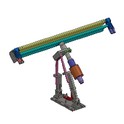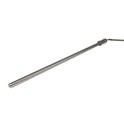As a supplier of the ResoLab - 1000 Lab Grade Ultrasonicator, I've often been asked whether this powerful piece of equipment can be used for cosmetic sample processing. In this blog, I'll dive deep into the capabilities of the ResoLab - 1000 and explore its suitability for various cosmetic - related applications.
First, let's understand what the ResoLab - 1000 Lab Grade Ultrasonicator does. It's a high - end device that generates ultrasonic waves. These waves create a phenomenon called cavitation, where tiny bubbles are formed and rapidly collapse in a liquid medium. This process releases a huge amount of energy, which can be utilized in multiple ways in a laboratory setting.
Emulsification in Cosmetics
One of the most common processes in cosmetic sample processing is emulsification. Emulsions are mixtures of two immiscible liquids, such as oil and water, where one is dispersed within the other. In cosmetics, emulsions are used in products like lotions, creams, and makeup.
The ResoLab - 1000 can be a game - changer for emulsification. The intense energy from ultrasonic cavitation breaks down the oil droplets into very small sizes. Smaller oil droplets lead to a more stable emulsion. A stable emulsion is crucial for cosmetics as it ensures that the product remains homogeneous during storage and use. Consumers expect a consistent texture and appearance every time they open a cosmetic product, and a well - emulsified sample is essential to meet these expectations.
The ResoLab - 1000 Lab Grade Ultrasonicator also allows for the production of emulsions with a narrow size distribution of droplets. This uniformity in droplet size can enhance the overall quality and performance of the cosmetic product. For example, in a facial cream, a uniform emulsion with small droplets can provide better skin penetration and a smoother feel on application.
Extraction of Active Ingredients
Cosmetics often contain various natural active ingredients, such as plant extracts, essential oils, and vitamins. Extracting these active components from their natural sources efficiently is a key step in cosmetic sample processing.
Ultrasonic extraction with the ResoLab - 1000 is highly effective. The ultrasonic waves penetrate the plant cells or other raw materials, causing them to break open. As the cells rupture, the active ingredients are released into the extraction solvent. This process is faster and more efficient compared to traditional extraction methods like Soxhlet extraction or maceration.
For instance, when extracting essential oils from herbs for use in a perfume or a fragrant body lotion, the ResoLab - 1000 can greatly reduce the extraction time and increase the yield of the active compounds. The improved extraction efficiency means that cosmetic manufacturers can get more value from their raw materials, which is not only economically beneficial but also environmentally friendly as it reduces waste.
Dispersing Pigments
In the production of colored cosmetics, such as lipsticks, eyeshadows, and foundations, proper dispersion of pigments is crucial. Pigments need to be evenly distributed in the cosmetic base to achieve a consistent color and a smooth texture.
The ResoLab - 1000 can effectively break up pigment agglomerates through the action of ultrasonic cavitation. When the ultrasonic waves are applied to a pigment - containing suspension, the bubbles formed and collapsed around the pigment particles exert a mechanical force on them. This force separates the agglomerated particles, ensuring that they are uniformly dispersed in the cosmetic formula.
A well - dispersed pigment results in a cosmetic product with a more intense and even color. For example, in a high - end eyeshadow, proper pigment dispersion creates a rich and smooth color payoff, enhancing the aesthetic appeal and the user experience.
Comparison with Other Models
While the ResoLab - 1000 is a great choice for many cosmetic sample processing applications, we also offer other models in our product line that might be more suitable depending on the specific requirements.
The ResoLab - 500 Lab Grade Ultrasonicator is a more compact and less powerful option. It can be a good fit for smaller - scale cosmetic sample processing, especially in laboratories with limited space or for initial testing and formulation development. It might be ideal for a small - batch artisanal cosmetic maker who wants to experiment with different formulas on a limited budget.
On the other hand, the ResoLab - 2000 Lab Grade Ultrasonicator offers more power and larger capacity. For large - scale cosmetic manufacturers who need to process a high volume of samples, this model can significantly increase productivity. It can handle larger batches of emulsions, extractions, or pigment dispersions in a shorter time, making it a valuable investment for industrial - scale operations.
Considerations for Cosmetic Sample Processing
When using the ResoLab - 1000 for cosmetic sample processing, there are a few things to keep in mind. First, the choice of parameters such as ultrasonic power, frequency, and processing time is critical. Different cosmetic formulations and processes may require specific settings to achieve the best results. For example, a more viscous emulsion may need a higher ultrasonic power and a longer processing time compared to a thin - consistency lotion.
Second, the compatibility of the sample and the container with the ultrasonic process is important. Some cosmetic formulations may be sensitive to high - energy ultrasonic waves, and certain containers may not be suitable for ultrasonic treatment. It's essential to conduct compatibility tests before starting full - scale processing.


Conclusion
In summary, the ResoLab - 1000 Lab Grade Ultrasonicator is a versatile and valuable tool for cosmetic sample processing. It can be used for emulsification, extraction of active ingredients, and dispersing pigments, all of which are key steps in the production of high - quality cosmetic products. Whether you are a small - scale cosmetic formulator or a large - scale manufacturer, this equipment can help you achieve better results in your sample processing.
If you're interested in learning more about how the ResoLab - 1000 or our other models can fit your cosmetic sample processing needs, don't hesitate to reach out for further discussions. We are committed to providing you with the best solutions for your cosmetic production challenges.
References
- Mason, T. J., Povey, M. J. W., Ptacek, P. L., & Miles, P. J. (2011). Sonochemistry. Royal Society of Chemistry.
- Chemat, F., Khan, M. K., & Cravotto, G. (2017). Green extraction of natural products. perspectives for sustainable development. Elsevier.





